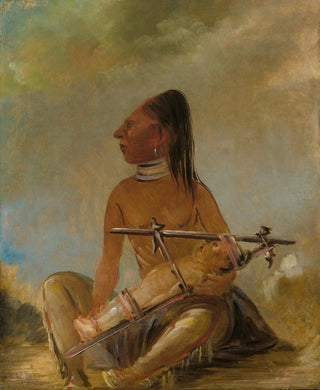Art print | Woman and child showing how children's heads are flattened - George Catlin


View from behind

Frame (optional)
In the fascinating universe of art, some works stand out for their ability to capture moments of life and convey profound stories. The art print Femme and child showing how the heads of children are flattened - George Catlin is one of those pieces that invites reflection on the customs and traditions of Indigenous peoples of America. Through this representation, Catlin does not merely depict a scene; he offers a glimpse into the culture and ritual practices of the tribes he encountered during his travels. This painting, imbued with a unique sensitivity, sparks curiosity about ancestral practices and lifestyles that have shaped the identity of these communities.
Style and uniqueness of the work
George Catlin's work is characterized by a realistic and detailed approach, blending meticulous observation with artistic sensitivity. In Femme and child showing how the heads of children are flattened, the viewer's gaze is immediately drawn to the posture of the characters, which evokes both tenderness and tradition. The vivid colors and carefully rendered textures bring this scene to life, creating an atmosphere that is both intimate and revealing. Catlin succeeds in immortalizing a moment of cultural transmission, where the mother shares with her child an ancestral knowledge. This art print stands out for its ability to combine aesthetics and anthropology, offering a nuanced view of daily life and cultural practices of the peoples he depicted.
The artist and his influence
George Catlin, painter and explorer of the 19th century, dedicated a significant part of his life to documenting Native American cultures. Traveling across the United States, he created a series of works that testify to the richness and diversity of Indigenous traditions. Catlin was one of the first artists to raise public awareness of the beauty of Native American cultures, while also denouncing their decline in the face of colonial expansion. His commitment to preserving these cultures is reflected in each canvas, where he seeks to immortalize practices on the verge of disappearing. Through his work, Catlin paved the way for a better understanding of

Matte finish

View from behind

Frame (optional)
In the fascinating universe of art, some works stand out for their ability to capture moments of life and convey profound stories. The art print Femme and child showing how the heads of children are flattened - George Catlin is one of those pieces that invites reflection on the customs and traditions of Indigenous peoples of America. Through this representation, Catlin does not merely depict a scene; he offers a glimpse into the culture and ritual practices of the tribes he encountered during his travels. This painting, imbued with a unique sensitivity, sparks curiosity about ancestral practices and lifestyles that have shaped the identity of these communities.
Style and uniqueness of the work
George Catlin's work is characterized by a realistic and detailed approach, blending meticulous observation with artistic sensitivity. In Femme and child showing how the heads of children are flattened, the viewer's gaze is immediately drawn to the posture of the characters, which evokes both tenderness and tradition. The vivid colors and carefully rendered textures bring this scene to life, creating an atmosphere that is both intimate and revealing. Catlin succeeds in immortalizing a moment of cultural transmission, where the mother shares with her child an ancestral knowledge. This art print stands out for its ability to combine aesthetics and anthropology, offering a nuanced view of daily life and cultural practices of the peoples he depicted.
The artist and his influence
George Catlin, painter and explorer of the 19th century, dedicated a significant part of his life to documenting Native American cultures. Traveling across the United States, he created a series of works that testify to the richness and diversity of Indigenous traditions. Catlin was one of the first artists to raise public awareness of the beauty of Native American cultures, while also denouncing their decline in the face of colonial expansion. His commitment to preserving these cultures is reflected in each canvas, where he seeks to immortalize practices on the verge of disappearing. Through his work, Catlin paved the way for a better understanding of






